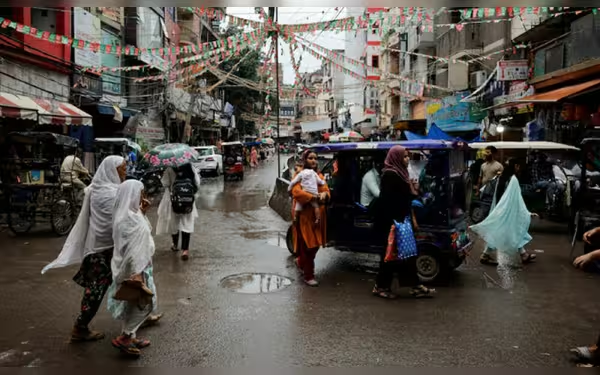Thursday, November 7, 2024 01:09 PM
Muslim Segregation in New Delhi: A Response to Rising Insecurity
- Muslims seek safety in segregated neighborhoods.
- 2020 riots intensified communal fears among Muslims.
- Experts link segregation to rising Islamophobia.
 Image Credits: brecorder
Image Credits: brecorderThe segregation of Muslims in New Delhi reflects rising insecurity and fear following the 2020 riots, driven by increasing Islamophobia.
In recent years, the landscape of communal relations in India has undergone significant changes, particularly for the Muslim community. The events of February 2020 marked a turning point, as riots erupted in New Delhi, targeting Muslims and leading to a wave of fear and insecurity. This violence has prompted many Muslims to seek refuge in areas with larger Muslim populations, effectively creating enclaves that offer a sense of safety amidst rising tensions.
Nasreen and her husband Tofik are among those who have felt the impact of these riots firsthand. After Tofik was brutally attacked and injured during the violence, the couple made the difficult decision to leave their home in Shiv Vihar and relocate to Loni, a less developed area with a significant Muslim community. Tofik expressed his sentiments clearly, stating, "I will not go back to that area. I feel safer among Muslims." This sentiment is echoed by many others who have chosen to congregate in Muslim-majority neighborhoods, seeking solace in numbers.
The phenomenon of segregation among Muslims in New Delhi has been observed by various local leaders, activists, and real estate agents. They report that areas like Jamia Nagar, traditionally a sanctuary for Muslims during communal riots, are now overflowing with new residents. Raes Khan, a real estate agent, noted that Muslim clients are increasingly seeking homes in these areas, driven by a desire for safety. He remarked, "No matter how brave a Muslim might be, they feel they have to move because if a mob comes, how brave can you really be?" This highlights the pervasive fear that has taken root in the community.
Experts have pointed to rising Islamophobia as a key factor contributing to this trend. Raphael Susewind, a political anthropologist, has conducted extensive research on the Muslim population in India and noted that segregation has significantly increased over the past decade. The political climate, particularly under Prime Minister Narendra Modi's Bharatiya Janata Party (BJP), has been cited as a major driver of this phenomenon. The 2020 riots, which resulted in numerous injuries and fatalities, have left a lasting impact on the community, prompting many to seek safety in numbers.
Despite the lack of official data on segregation, anecdotal evidence suggests a growing trend. For instance, Md Sahil, a clergyman in Jamia Nagar, reported that attendance at his mosque's early morning prayers has more than doubled in recent years, reflecting the increasing population in the area. This shift is not merely a matter of preference; it is a response to the very real threats faced by the community.
While some officials suggest that economic factors may drive poorer Muslims to live in segregated areas, many community leaders argue that the push for sectarian cloistering is primarily a reaction to violence and discrimination. The 2020 riots, which were fueled by political rhetoric and anti-Muslim sentiment, have left deep scars on the community, making safety a paramount concern.
As the situation continues to evolve, it is crucial to recognize the implications of these developments. The increasing segregation of Muslims in New Delhi is not just a local issue; it reflects broader societal tensions that can have far-reaching consequences. Understanding the motivations behind this trend is essential for fostering dialogue and promoting coexistence in a diverse society. Ultimately, the quest for safety and security among marginalized communities should be a call to action for all, urging society to address the root causes of fear and division.













